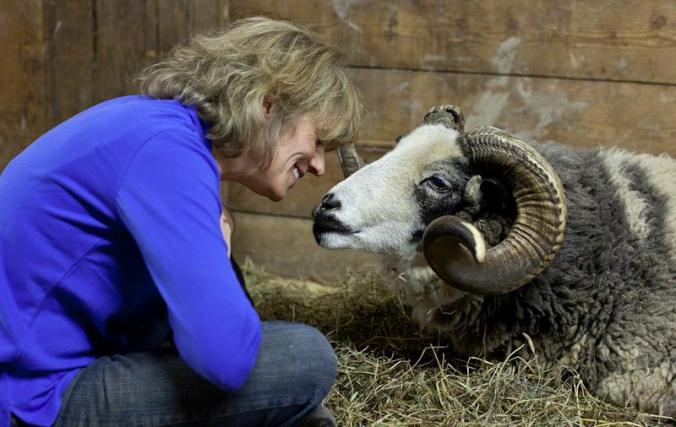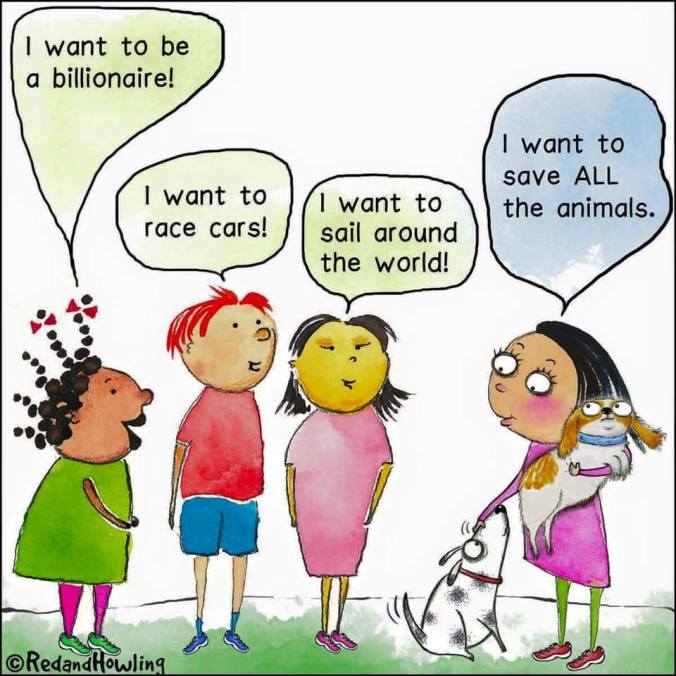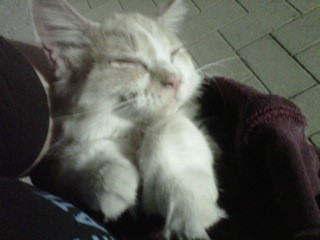“Lots of people talk to animals … not very many listen though … that’s the problem.”
Benjamin Hoff, The Tao of Pooh
“Lots of people talk to animals … not very many listen though … that’s the problem.”
Benjamin Hoff, The Tao of Pooh
A while ago, while doing some research for an article I was writing about the ins and outs of running an obedience school for dogs, I asked the person with whom I was speaking if they would also be interested in being interviewed for the regular feature I write in the Toronto Star called, Pet Psyche. I explained it was a lighthearted take on the questionnaire made famous by French novelist Marcel Proust in which pet owners answer on behalf of their furry friends.
There was a brief silence, followed by a clearing of the throat. My interviewee then politely explained that he knew of the column and had read it once, and would be happy to talk about life as a dog trainer, but would have to pass on the other article as he did not believe in anthropomorphizing animals – or in other words, assigning human attributes to them.
Fair enough I thought.
In the relatively short time I’ve been actively involved in the world of animal welfare and advocacy I’ve discovered it resembles a rich tapestry in which multiple layers and textures and colours are all woven together to create something beautiful – the collective love of animals.
To me, the idea of anthropomorphization is a fascinating one – and renowned ecologist and writer, Carl Safina explores this multifaceted notion in his thought-provoking TED Talk (October 2015) What are animals thinking and feeling?
At one point, Carl explains that “… attributing human thoughts and emotions to other species is the best first guess about what they’re doing and how they’re feeling because their brains are basically the same as ours, they have the same structures – the same hormones that create mood and motivation in us are in those brains as well.”
Simply put, Carl goes on to say, we don’t need science to determine that an animal is hungry when it is hunting, or tired when it’s panting with its tongue hanging out, “and then say when they’re playing with their children and acting joyful and happy we have no idea if they can possibly be experiencing anything. That is not scientific.”
 Kathy Stevens with the indomitable Rambo – Catskill Animal Sanctuary.
Kathy Stevens with the indomitable Rambo – Catskill Animal Sanctuary.
Another striking example of an animal displaying emotions we usually attribute to human beings comes from Kathy Stevens, Founder & ED of Catskill Animal Sanctuary. In the short video below she describes a life-changing encounter with one of her rescues – a magnificent sheep named Rambo.
As Kathy was getting ready to close up the barn one evening, Rambo ran up to her, looked her straight in the eye, and bleated very pointedly, “Baaaaa!” Recognizing his sense of urgency, she asked him to show her what was wrong. Rambo walked down the barn and into an empty stall, turned around and looked at her. Somehow, Kathy had forgotten to bring in the sanctuary’s two turkeys for the night, and Rambo was telling her as much.
“He knew those birds were out there, he knew they weren’t supposed to be, he figured out how to tell a human being. He knew that I would help them which made me understand that he gets what this place is – and he had empathy. A sheep who had never known kindness had empathy for two animals who were in trouble – and knew that I would help them. And that moment changed my life.”
What I have discovered from interviewing pet owners from all walks of life is that they love their animal companions a great deal. And, while guessing what their furry or feathered or even finned friend might be “thinking” can be a humorous, tongue-in-cheek exercise at times – it also demonstrates a deep and profound connection between the two of them. Humans are attuned to the moods and needs and preferences of their animal companions, and the nature of their relationship allows them to recognize joy and sadness and worry as easily as hunger and fatigue – which, as Carl Safina points out, are not based on scientific analysis, but rather the recognition of a state of being.
When the end game is a more compassionate world – and in particular, the humane treatment of all species – every person who makes that their mission is entitled to forge their own path – and form their own conclusions when it comes to relating to the non-human types among us.
“Not all of us can do great things. But we can do small things with great love.”
Mother Teresa

When I came across this delightful drawing by the talented Amy Luwis of Red and Howling it reminded me of the very first conversation I had with Gene Baur, President and Co-Founder of Farm Sanctuary. It was back in June of 2012 and I was in Los Angeles attending a fundraiser for the organization – aptly named, A Celebration of Expanding Compassion.
I had just finished reading Gene’s book, Farm Sanctuary: Changing Hearts and Minds About Animals and Food in preparation for the event. It wasn’t required reading, but being relatively new to the world of animal advocacy at the time, I was eager to broaden my understanding of potential issues and challenges facing someone who had recently – and wholeheartedly – committed herself to the pursuit of living a more compassionate life.
It was a hard read, and I found myself sobbing through the chapters that revealed details of atrocities that were commonplace – or otherwise known as “industry standards and practises” in the world of industrial agriculture. The more I read, the more I became aware that I was rapidly heading in to unfamiliar and overwhelming territory.
There was no turning back – and while I wasn’t looking for a way out, I knew I needed some guidance from those who had successfully navigated this particular leg of the journey. I had to know how they learned to forge ahead with meaning and purpose and hope amidst the heartache. And how their desire to make a difference continued to override their feelings of despair because frankly, the two were neck in neck for me, and despair was inching its way forward at an uncomfortable pace.
The evening was picture perfect. Designer Michael S. Smith and his partner, HBO Executive (at the time), James Costos, graciously opened their beautiful Beverly Hills home to Farm Sanctuary devotees, and the evening had an air of excitement with the arrival of celebrity supporters and well-known leaders in the animal welfare movement. Aspiring actors moonlighting as servers made the rounds with shiny silver trays of delectable vegan hors d’oeuvres while photographers roamed the lush green gardens capturing memories for new friends and familiar faces alike.
During the formal part of the evening, Susie Coston, Farm Sanctuary’s National Shelter Director, spoke to the evening’s theme of “expanding compassion” by announcing the opening of a third sanctuary in southern California.
She then shared the stories of two animals – Sonny and Fanny – both beautiful Holsteins, both deemed disposable by the dairy industry.
As a male calf, Sonny was useless to the milk-producing business and was left to die in a “filthy stockyard pen” shortly after being born. Susie went on to explain, “His umbilical cord had been torn off, leaving an open wound, and he was dehydrated, exhausted and sick from infection. Without intervention, he would have died after a few more hours of misery.”
Fanny was a ‘spent’ dairy cow, and having reached the end of her milk-producing years, was being sent to auction for slaughter for ground beef or pet food. However, as a result of “egregious neglect” she was unable to walk to her fate. As Susie described, “Her horribly overgrown hooves made every step excruciating and her legs buckled under the weight of her enormous udders. Instead of trying to help her, stockyard workers hit Fanny with wooden poles to force her to move.”
Susie’s eloquent recounting of the lives Sonny and Fanny lived before their rescue was honest and raw and jarring, and reminded us all of the reasons we were there on that beautiful southern California evening in June.
Gene then took the podium to thank the evening’s hosts, and recognize various individuals for their outstanding contribution to the animal welfare movement. After he brought the formal part of the evening to a close, I made my way over to express my gratitude for their relentless and inspiring pursuit of a more compassionate world.
 PHOTO: Farm Sanctuary
PHOTO: Farm Sanctuary
Shortly after introducing myself to Gene, and mentioning that I’d just finished reading his book, I felt my voice catch and my eyes well up. I then found myself blurting out how much his book had impacted me and how I was new to the world of animal advocacy and was struggling with the knowledge of the sheer numbers in terms of animals that were suffering every single day in the name of food production and how did he reconcile that in his mind. I then took a much-needed breath. Definitely not the way I envisioned the conversation going. But it was clearly what needed to be conveyed.
Gene smiled, and the look of genuine empathy that washed over his kind face instantly put me at ease. This was obviously not the first time he had heard an impassioned entreaty like mine – well, not in the form of a run-on sentence without punctuation or a single breath in between thoughts – but the sentiment was definitely familiar to him.
“I had to come to terms with the fact that I can’t save them all. And once I did, I realized that focusing on the ones I can save will make a difference, especially by sharing their story.”
His words were a salve for the soul.
I could let all of the seemingly insurmountable challenges facing the animal welfare movement stop me in my tracks – at a loss for where to even begin – or I could start exactly where I was, with the skills and knowledge and expertise I had, and make a difference to a least some of them. And Gene’s wise words reminded me that the ones I could save were waiting for me.
 PHOTO: Farm Sanctuary
PHOTO: Farm Sanctuary
See Susie Coston’s blog for her thoughts on rescue, advocacy and leading a more compassionate life. Also, see how the wonderful Sonny is doing today!
“Our task must be to free ourselves by widening our circle of compassion to embrace all living creatures and the whole of nature in its beauty.”
Albert Einstein
The other day, while interviewing a woman and her feline companion for a regular feature I write in the Toronto Star, the subject of animal welfare and advocacy came up. During these exchanges, interviewees often ask about my background, and how I came to write Pet Psyche – a lighthearted take on the questionnaire made famous by French novelist Marcel Proust in which pet owners answer on behalf of their furry friends. On this particular occasion, Kara expressed her desire to get involved in animal advocacy in some capacity but confessed she had no idea how or where to begin.
My journey to the animal welfare pursuits in which I’m involved today actually started as a result of a rough patch in my career. To quell a growing dissatisfaction with my professional life, I started to look for something to be passionate about outside of the boardroom, while figuring out my next career move.
Being a senior manager leading a team of 14, I was removed from the creative, hands-on involvement in the business – one of my passions – so enrolled in a magazine writing course at a nearby college. Also, I had often toyed with the idea of fostering shelter animals, and decided it was time to look into that in earnest as well.
A few days later, at the end of yet another long meeting, I overheard a colleague mention how well the two rescue dogs she was fostering were doing. Eager to hear more, I decided to hang back and listen in on the conversation as the rest of my colleagues hurriedly took their leave, smartphones a blazing.
It was that simple decision – to join a conversation – that opened up an entire world to me.
Meredith recounted the story of one of her canine charges – he was found chained to a fence post in a cemetery, left there to die. And while I still feel gutted every time I come across a story like this, I knew I wanted in. I knew I was ready to get involved. Meredith later sent me a link to the C4P Animal Rescue newsletter and as soon as I saw it, realized I’d been a subscriber a few years back, but for some reason didn’t renew when my e-mail coordinates changed. I re-subscribed, and in the first copy I received, I came across a cat who needed fostering.
 Charlotte’s rescue photo
Charlotte’s rescue photo
There was something about her face that resonated deeply with me, and after a brief e-mail exchange, one detailed application, and a follow-up phone conversation later, ‘Charlotte’ was in my care. Within 24 hours I knew I had to adopt her. I also realized that, while fostering wasn’t going to work for me (I already had three rescue cats), myriad ways to get involved were opening up.
It was in that same newsletter that I also came across a link to Farm Sanctuary, the largest farm animal rescue organization in North America.
And so began my journey into animal welfare and advocacy, and my love affair with compassionate living.